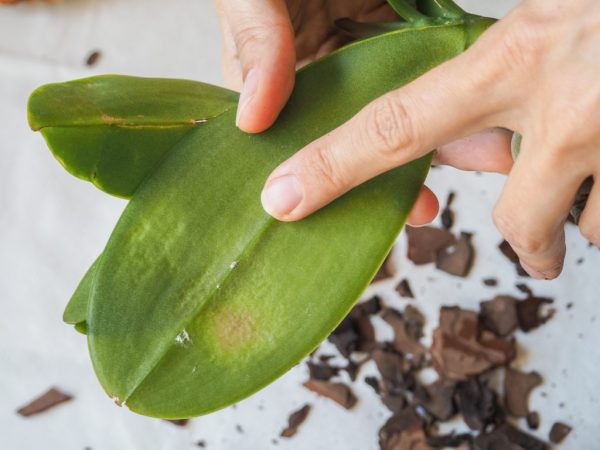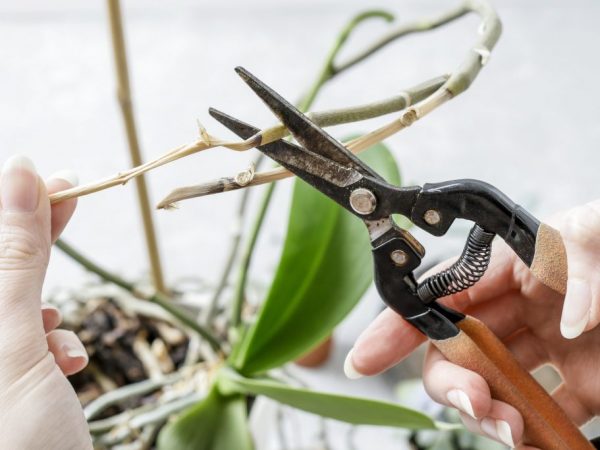Why does the stem of an orchid dry
Many who grow phalaenopsis are interested in why the stem of the orchid dries and how to save the flower. If the stem of an orchid turns yellow, natural aging is the main source of the problem. There are other factors that affect the condition of the stem.

Why does the stem of an orchid dry
Natural process
The part of the plant called the stem depends on the variety of the flower. For example, in phalaenopsis, it is the peduncle that is considered to be the stem, and in dendrobium it is the bulb. In order for the orchid to delight with new flowers and feel good, it requires proper care. Knowledge of the main features of the content will help to avoid problems, namely, all Phalaenopsis are susceptible to new conditions and are afraid of changing the place of growth.
Slightly yellowed lower leaves of Phalaenopsis are common. Green leaves live for a certain period, namely from 3 to 5 years, after this period the leaf gradually becomes soft, withers, turns yellow, and soon dries up. It is also natural for the faded orchid stem to dry out.
After the plant has released buds, and then safely bloomed and dropped them only after 3-6 months, events can develop in two ways:
- the peduncle continues to be green and prepares for re-flowering;
- the stem is already yellow and pruning is required.
Most often, after acquiring a beautiful flowering phalaenopsis, you can see that it begins to shed flowers, the buds turn yellow, and then the stem of the orchid turns yellow. This suggests that the plant has undergone stress due to a change in conditions and place of residence. However, phalaenopsis quickly gets used to its habitat and soon grows green mass and roots. And then the growing season begins and soon the plant releases a new peduncle.

Slightly yellowed lower leaves of Phalaenopsis are common.
If the stem of the orchid turns yellow, you can cut off the yellowed stem completely or only until the next dormant bud.
- If the peduncle is dry and turns yellow to a certain area, but partially still alive, then the flower has decided to release the baby from the bud or lateral peduncle. Lateral shoots do not bloom so abundantly, so to speak - poorly.
- Completely cut off the peduncle, which has already bloomed from the crown, so that their bush in the future will spend energy only on large and harmonious flowering.
Growing point fading
Also, with phalaenopsis, an unpleasant problem sometimes arises - the growth point may begin to die. The orchid is a monopodial plant with only one growth point. If it dies, then, unfortunately, the plant cannot be saved. To prevent this from happening, you need to remember the causes of death and try to adhere to the rules of cultivation. Decay remains the most popular cause.
Phalaenopsis loves warmth and does not tolerate excess moisture. In just 24 hours, almost the entire root system decays if it is in water.After watering, be sure to pour out all the water from the trays so as not to lose your favorite flowers. If all the leaves began to fall off and their color has acquired a putrid-dark shade, this means that the growth point has rotted. The neck also becomes dark and soft to the touch.

Also, with phalaenopsis, an unpleasant problem sometimes arises - the growth point may begin to die
Drying out also causes the death of the growing point, only the plant dies more slowly. Phalaenopsis goes without water for a long time, but no more than a couple of months. Over time, the bush shows signs of dehydration, the leaves begin to turn yellow, the roots die off, and ultimately dies. If the stem of the orchid turns yellow and all the leaves have fallen off, but at the same time there are doubts that the growth point has died, it is worth leaving the pot with the root system alone for several months, because there is a possibility that a lateral cervical baby will sprout and then not everything will be with the flower lost.
Pruning
A faded orchid must be cut according to the rules so as not to destroy the plant.
When to prune your orchid
The time from early October to November inclusive is considered the best period for this procedure, and it is suitable for almost any type of this wonderful plant. But, exotic species (artificial hybrids) are pruned only in the spring, from the first days of March until the end of the month. The name of the flower indicates a hybrid or original variety.
Therefore, when acquiring a phalaenopsis for yourself, be sure to pay attention to the name (or write it down), because his whole future life in the house will depend on it.
Using tools when trimming
Oddly enough, but better for this are metal scissors or a simple garden shears for pruning - pruning shears.
Be sure to disinfect the tool you decide to use with a solution of ordinary bleach. Try not to prune with a knife, as you can easily accidentally damage the leaves.

A faded orchid must be cut according to the rules so as not to destroy the plant.
Pruning rules
First of all, carefully examine the flower, check for dormant buds, from which children or new flowers can grow.
- In order for the phalaenopsis to bloom again, you need to count down three dormant buds and about 10-15 mm above the last and cut the peduncle there. Please note that this pruning method does not have a 100% guarantee that this peduncle will have buds or kidneys of children.
- In addition, if the peduncle is cut from above in this way, then there is a chance of a flower emerging, but a new trunk is unlikely to grow, because the plant will use all its resources to support the old stem.
Pruning the entire peduncle
A yellowed or completely shriveled stem must be cut off entirely, leaving only a small piece no more than 20 mm in size. Do not feel sorry for the cut peduncles, because soon the phalaenopsis will again delight you with its beautiful flowers.
Orchid after pruning
Caring for such a phalaenopsis is no different from the usual. You just need to fertilize the plant with top dressing to accelerate the growth of new leaves and the appearance of flowers. If the plant is resting after flowering, then you should not add fertilizer during this period.
Conclusion
In addition to changing the conditions of detention and changing the place of residence, there are several more reasons why the stem of an orchid turns yellow, we are talking about insects and diseases. Therefore, you should always inspect the plant, its leaves and roots.

